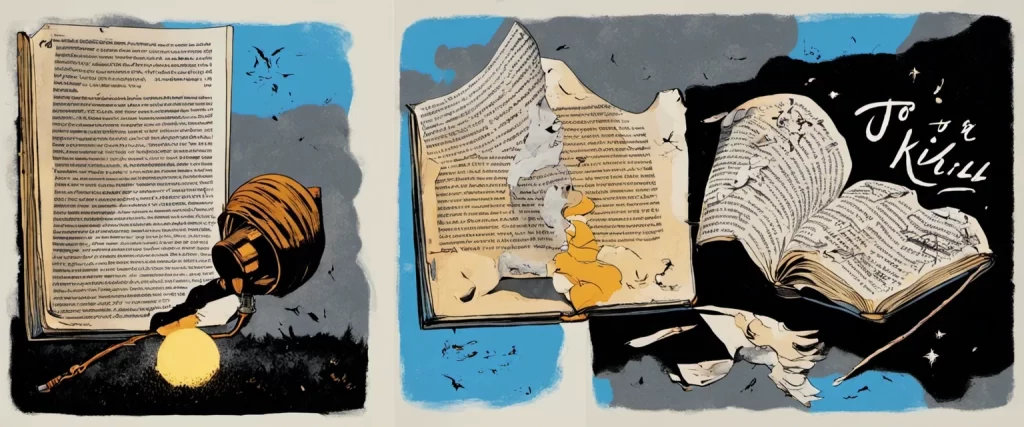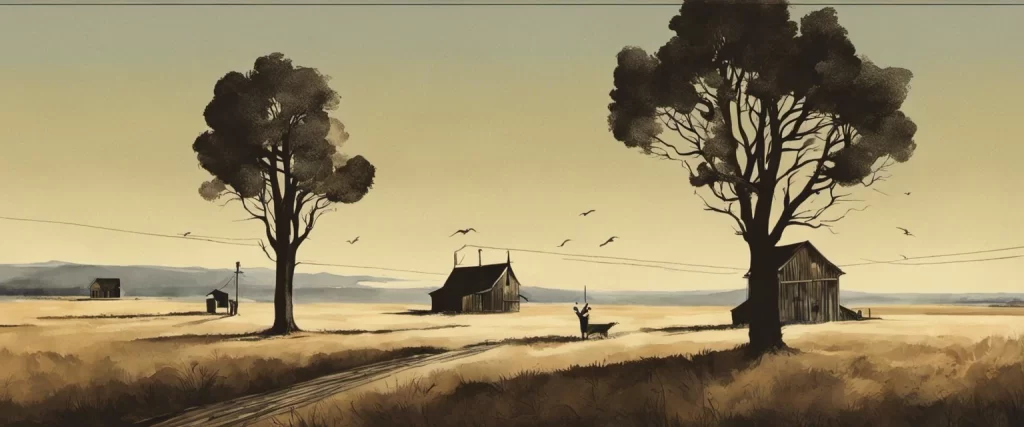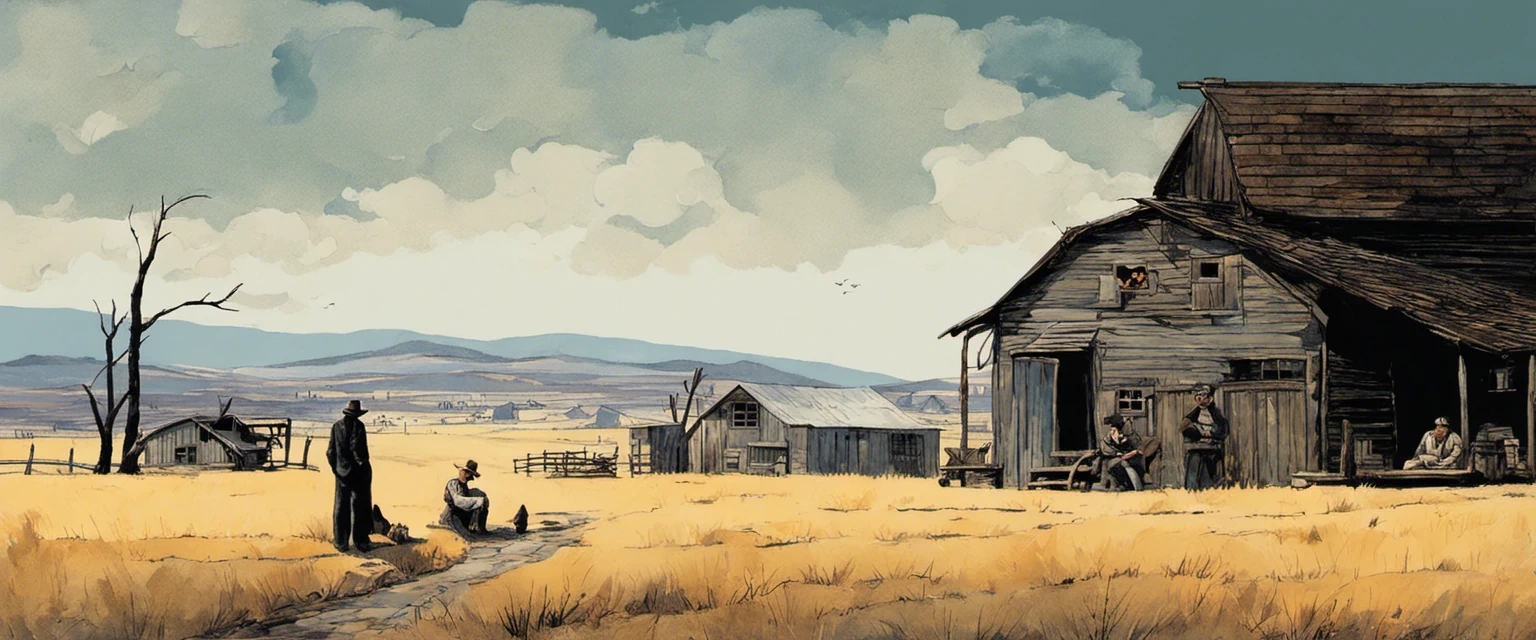——Of Mice and Men & To Kill a Mockingbird
In the vast landscape of literature, certain works have stood the test of time, becoming timeless classics that continue to captivate and resonate with readers across generations. Among these cherished novels, John Steinbeck’s “Of Mice and Men” and Harper Lee’s “To Kill a Mockingbird” rise to prominence as vivid portrayals of the flawed yet beautiful facets of human nature and society. As we delve into a comparative study of these literary masterpieces, we embark on a journey that traverses themes of prejudice, injustice, friendship, resilience, and the pursuit of the American Dream.
Published in 1937, “Of Mice and Men” explores the lives of two displaced ranch workers, George and Lennie, as they navigate the harsh realities of the Great Depression. Set against the backdrop of California’s Salinas Valley, John Steinbeck’s novella delves deep into the complexities of friendship, dreams, and the struggles of the working class. Through vivid descriptions and poignant storytelling, Steinbeck exposes the inherent vulnerabilities of the human psyche, addressing themes of loneliness, sacrifice, and the quest for independence.
Meanwhile, Harper Lee’s “To Kill a Mockingbird,” first published in 1960, takes readers to the deep South during the height of racial tensions in 1930s Alabama. Told through the eyes of the young and curious Scout Finch, Lee’s novel peels back the layers of a community brimming with prejudice, injustice, and moral ambiguity. As the daughter of respected lawyer Atticus Finch, Scout becomes embroiled in a harrowing tale of racism and integrity, witnessing the trials and tribulations of her father’s defense of an innocent African American man accused of rape. Through its powerful narrative, “To Kill a Mockingbird” confronts issues of race, class, and the moral conscience of a society teetering on the edge of transformation.
Both novels, though distinct in their settings and narrative styles, present readers with unforgettable characters confronted by their respective worlds’ challenges. While “Of Mice and Men” portrays the intimate bond between George and Lennie, two contrasting yet complementary individuals, “To Kill a Mockingbird” offers an array of complex characters, each grappling with their own prejudices and beliefs. Through the examination of these characters, Steinbeck and Lee invite us to scrutinize the societal norms and prejudices that perpetuate injustice, forcing us to confront uncomfortable truths about the human condition.
Moreover, the authors challenge conventional notions of heroism and bravery. In “Of Mice and Men,” Steinbeck presents George’s sacrificial acts for the betterment of his simple-minded friend Lennie. In contrast, “To Kill a Mockingbird” showcases Atticus Finch’s unwavering dedication to justice, even in the face of overwhelming opposition. These depictions allow us to ponder the multifaceted nature of heroism and the choices we make when confronted with adversity.
As we embark on this comparative study of “Of Mice and Men” and “To Kill a Mockingbird,” we will unpack the unique ways in which Steinbeck and Lee intertwine social commentary with powerful storytelling, as well as examine the profound influence both novels have had on shaping our understanding of the human experience. Through exploring their shared themes, character development, and narrative techniques, we will gain a deeper appreciation for the enduring relevance and profound impact of these literary masterpieces.
Brief Summary of Two Books
Of Mice and Men by John Steinbeck
Of Mice and Men by John Steinbeck is set during the Great Depression in the 1930s and tells the story of two close friends, George Milton and Lennie Small. George is small and quick-witted, while Lennie is large and mentally disabled, but George looks after him like a brother.
The duo dreams of owning their own piece of land, where they can live off the fat of the land and be their own bosses. They find work at a ranch in Soledad, California, and befriend other ranch hands, including the kind-hearted Slim, the bitter and one-handed Crooks, and the flirtatious and unfaithful Curley’s wife.
As the story unfolds, the characters’ dreams collide with the harsh realities of their lives. Tragedy strikes when Lennie accidentally kills the ranch owner’s wife in a moment of panic. Recognizing that he can no longer protect Lennie from the consequences, George makes the difficult decision to mercifully kill him himself to spare him a worse fate at the hands of a vengeful mob.
The novel explores themes of friendship, dreams, loneliness, and the struggle for survival amidst a harsh and unforgiving world. It delves into the themes of the human condition, reflecting on the complexities and challenges of life during a time of great hardship.
To Kill a Mockingbird by Harper Lee
To Kill a Mockingbird by Harper Lee is a classic novel set in the 1930s in Maycomb, Alabama. The story is narrated by Scout Finch, a young girl who lives with her older brother Jem and their widowed father Atticus, who is a lawyer. The story revolves around the trial of Tom Robinson, a black man accused of raping a white woman, Mayella Ewell.
Scout and Jem befriend a boy named Dill and become obsessed with their reclusive neighbor, Boo Radley, who is rumored to be a dangerous and mentally unstable figure. As Scout and Jem grow up, they learn valuable lessons about racism, prejudice, and the injustices of their society.
Atticus takes on Tom Robinson’s case, despite the prejudice of the community. He provides a strong defense, highlighting the lack of evidence against Tom and exposing the lies of Mayella and her abusive father, Bob Ewell. However, Tom is still unjustly convicted by an all-white jury due to the racism deeply ingrained in Maycomb.
After the trial, Bob Ewell, seeking revenge, attacks Scout and Jem. However, Boo Radley intervenes and saves them, finally revealing himself to the children. Scout, who had once been afraid of Boo, now sees him as a kind and caring person.
“To Kill a Mockingbird” is a poignant tale that explores themes of racial injustice, the loss of innocence, and the power of empathy and compassion. It serves as a powerful social commentary on the deep-rooted prejudices existing in society.
Comparison between Two Books

Similarities in human condition
Both Of Mice and Men by John Steinbeck and To Kill a Mockingbird by Harper Lee explore various aspects of the human condition, highlighting similarities in the struggles, injustices, and marginalization experienced by different individuals or groups. Here are some key similarities:
1. Marginalized and outcast characters: In both novels, there are characters who are marginalized and face discrimination due to factors beyond their control. Steinbeck’s character, Lennie Small, is mentally disabled and faces social ostracization. Similarly, Harper Lee’s character, Boo Radley, lives as a recluse due to societal condemnation. Both characters suffer from isolation and find themselves on the fringes of society.
2. Themes of racial inequality: Both books address the issue of racial discrimination and its consequences. In To Kill a Mockingbird, Harper Lee focuses on the case of Tom Robinson, a black man falsely accused of rape, and highlights the deep-rooted racism prevalent in the society. Steinbeck’s novel depicts racism towards Crooks, the African-American stable-hand, who faces constant discrimination solely based on his race. Both authors emphasize the painful reality of racial inequality and the impact it has on individuals.
3. The plight of the working class: Both novels present the struggles faced by individuals from the working class who are trapped in difficult circumstances. Of Mice and Men explores the challenging lives of migrant workers during the Great Depression, highlighting their limited opportunities, low wages, and lack of stability. Similarly, in To Kill a Mockingbird, Harper Lee depicts the poverty and uncertainties faced by characters like the Cunninghams, showcasing the pervasive hardships endured by the working class.
4. Loss of innocence: Another similarity lies in the loss of innocence experienced by characters in both novels. In To Kill a Mockingbird, Scout and Jem Finch encounter racism and injustice for the first time, challenging their naive perceptions of the world. Similarly, Lennie Small in Of Mice and Men possesses a childlike innocence that is ultimately shattered due to tragic events. Both narratives reflect the harsh realities of life that force characters to confront the darker aspects of human nature.
5. The power of friendship and empathy: Though both books depict the harshness of the human condition, they also explore the importance of friendship and empathy as sources of solace and resilience. In Of Mice and Men, George and Lennie’s friendship provides them with emotional support amidst a cruel world. In To Kill a Mockingbird, Scout’s friendship with Boo Radley teaches her the importance of understanding and empathy. Both novels highlight how genuine connections can bring hope and provide relief in challenging circumstances.
These similarities demonstrate the authors’ intent to shed light on the common struggles and injustices experienced by individuals, regardless of time period or setting, ultimately emphasizing the shared aspects of the human condition.
Divergences in human condition
Both Of Mice and Men by John Steinbeck and To Kill a Mockingbird by Harper Lee offer profound insights into the human condition, but they do so in vastly different contexts and with varied approaches. While both books explore themes of injustice, prejudice, and the plight of the marginalized, their divergences lie in the portrayal of social hierarchies, the significance of personal agency, and the ultimate potential for change.
In Of Mice and Men, Steinbeck examines the human condition within the context of the Great Depression and the American Dream. The narrative centers around the struggles of two itinerant ranch workers, George and Lennie, who dream of owning their own piece of land. Steinbeck portrays a society divided along economic lines, where power resides in the hands of those who possess wealth and control over resources. This hierarchy creates an environment in which the marginalized characters, such as Crooks, Candy, and Curley’s wife, suffer from discrimination and a lack of agency. The human condition, in this case, is presented as inherently unjust, with limited opportunities for upward mobility.
To Kill a Mockingbird, on the other hand, explores the human condition from the perspective of race, justice, and morality in the racially segregated Southern town of Maycomb during the 1930s. Lee highlights the pervasive prejudice and discrimination faced by African Americans through the lens of Scout Finch, a young white girl whose father, Atticus Finch, defends a black man falsely accused of rape. Lee portrays the deeply entrenched racial prejudices of the time, showing how they affect both the oppressed and the oppressors. However, she also introduces the concept of empathy and the potential for individuals to challenge societal norms. Atticus, as a moral beacon, teaches Scout and Jem the importance of seeing the world from others’ perspectives, ultimately suggesting that change is possible, albeit challenging.
The divergence in both books is evident in the role of personal agency and the potential for change. In Of Mice and Men, the characters are often trapped in predetermined roles, governed by inherent power imbalances and economic circumstances. Steinbeck, through the example of Lennie, suggests that individuals may be unable to break free from their circumstances or overcome their own limitations due to external and internal factors.
In contrast, To Kill a Mockingbird emphasizes the role of personal agency in addressing and rectifying societal injustices. Through characters like Atticus, Boo Radley, and Tom Robinson, Lee highlights the importance of individual actions and moral courage in fostering change within a deeply prejudiced society. Atticus’ unwavering belief in justice and his determination to defend Tom Robinson demonstrate the power of personal agency to confront and challenge the existing social order.
In conclusion, while both Of Mice and Men and To Kill a Mockingbird address the human condition within the context of injustice and discrimination, they diverge in their depiction of social hierarchies, the role of personal agency, and the potential for change. Steinbeck portrays a society where power and privilege are consolidated, while Lee suggests that personal agency and empathy can challenge prevailing social norms. Both books offer valuable insights into the human condition but within different contexts and through distinctive lenses.

Conclusion
Both “Of Mice and Men” by John Steinbeck and “To Kill a Mockingbird” by Harper Lee are considered classic works of literature and are worthy of reading. However, the choice ultimately depends on personal preferences and interests.
“Of Mice and Men” is a novella set during the Great Depression and follows the story of two migrant workers, George and Lennie, as they navigate the challenges of their impoverished lives. The book explores themes of friendship, dreams, loneliness, and the harsh realities of a society that does not value the marginalized.
“To Kill a Mockingbird” is a novel set in the segregated American South during the 1930s and centers around Scout Finch, a young girl growing up in a small town. The story revolves around themes of racial injustice, moral growth, and the loss of innocence. It is a powerful portrayal of racism and prejudice, as well as the individuals who fight against it.
Both books offer insightful social commentary and engaging narratives, but with different focuses. “Of Mice and Men” provides a poignant exploration of friendship and the human struggle for belonging, while “To Kill a Mockingbird” delves into the deep complexities of race and societal prejudices.
Ultimately, the decision on which book is more worthy of reading depends on the reader’s interests and what themes resonate with them the most.



